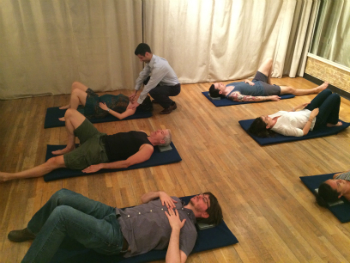 by Brooke Lieb
As part of our training course, our teachers-in-training design a multi-session group class syllabus, and present one of the classes to their class mates. I am always impressed by how creative and articulate our teachers-in-training are at teaching the concepts and principles of the work through guided explorations, partner activities and demonstration. One aspect of group class teaching is finding ways to practically apply Alexander principles to the task of daily living. Our teachers-in-training are always interested in the new teaching strategies to help a student make use of what they are learning in lessons and classes in real life.
by Brooke Lieb
As part of our training course, our teachers-in-training design a multi-session group class syllabus, and present one of the classes to their class mates. I am always impressed by how creative and articulate our teachers-in-training are at teaching the concepts and principles of the work through guided explorations, partner activities and demonstration. One aspect of group class teaching is finding ways to practically apply Alexander principles to the task of daily living. Our teachers-in-training are always interested in the new teaching strategies to help a student make use of what they are learning in lessons and classes in real life.
This past week in the training class (March 2015) I had the students work together in small groups to come up with ways to practically apply Alexander means-whereby to a simple activity. I suggested that they consider how to include the primary directions to organize the head/neck/back relationship while also addressing the specifics of the activity. We don’t need to teach the activity per se, we need to teach how to do it with better use by applying Alexander’s method.
The activities they chose were: crossing one leg over the other while seated (many of us realized after we were guided to direct ourselves and reorganize before we crossed a leg, we didn’t want to cross our legs anymore because we were so poised just sitting!); looking at email on our cell phones; and taking a drink from a cup.
One of the take-aways from the experience is that this approach to working with activities allows the whole group to participate simultaneously. Since it’s not possible to have hands on more than one student at a time, this is a useful method to keep the whole group engaged. Repetition of the activity and the verbal guidance allows the class participants to become familiar with the instructions to give themselves when they are on their own.
This was how Judith Leibowitz used to teach in her classes at Juilliard and on the Teacher Training Course at ACAT. She included many of the activities she taught as “The Leibowitz Procedures” in her book “The Alexander Technique” co-written with Bill Connington. Judy would take us all through the activity together, while she put hands on one student, and she would go from student to student as we all used the mirror to take ourselves through the activity.
Note: ACAT Teaching Members can log on the the member area here at www.acatnyc.org and view video of the ACAT Faculty reviewing some of Judy’s procedures on the “Members” page.
[author] [author_image timthumb='on']http://www.acatnyc.org/main/wp-content/uploads/2014/01/Brooke1web.jpg[/author_image] [author_info]N. BROOKE LIEB, Director of Teacher Certification since 2008, received her certification from ACAT in 1989, joined the faculty in 1992. Brooke has presented to 100s of people at numerous conferences, has taught at C. W. Post College, St. Rose College, Kutztown University, Pace University, The Actors Institute, The National Theatre Conservatory at the Denver Center for the Performing Arts, Dennison University, and Wagner College; and has made presentations for the Hospital for Special Surgery, the Scoliosis Foundation, and the Arthritis Foundation; Mercy College and Touro College, Departments of Physical Therapy; and Northern Westchester Hospital. Brooke maintains a teaching practice in NYC, specializing in working with people dealing with pain, back injuries and scoliosis; and performing artists. www.brookelieb.com[/author_info] [/author]
